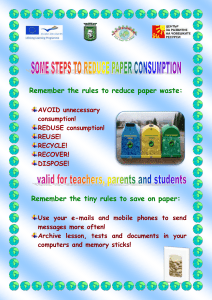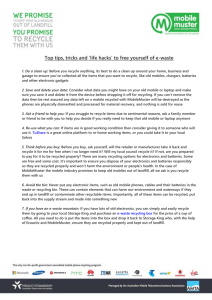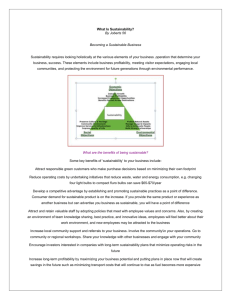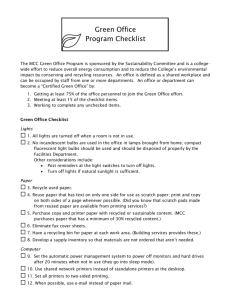10 Simple Sustainability Steps and NSF Personal Sustainability
advertisement
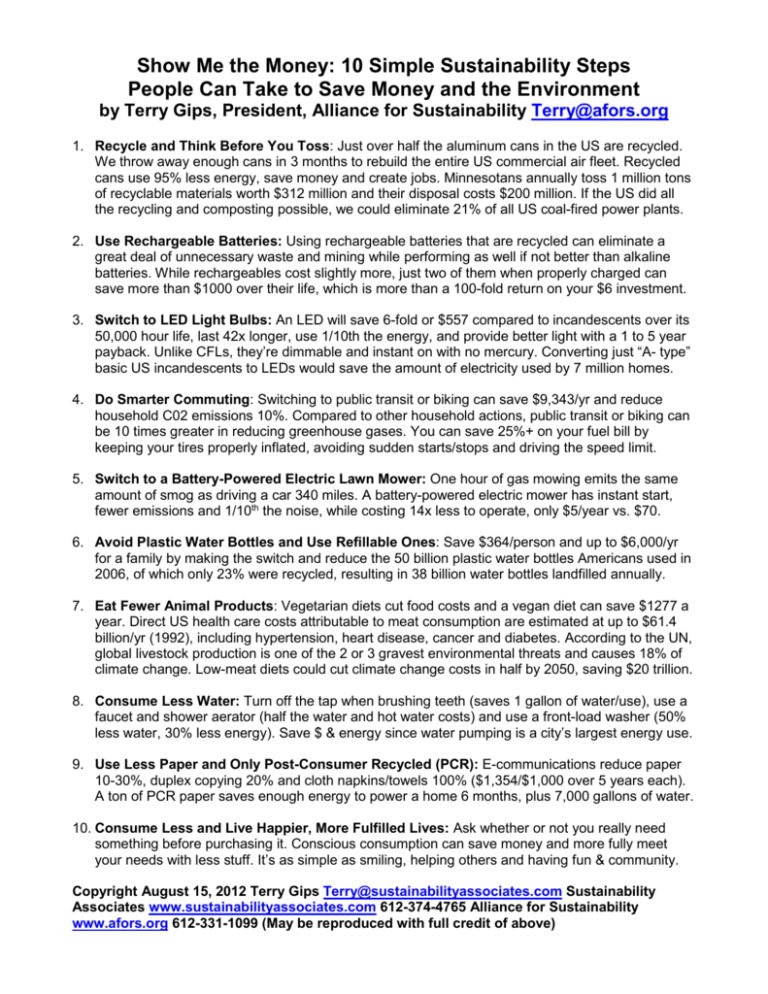
Show Me the Money: 10 Simple Sustainability Steps People Can Take to Save Money and the Environment by Terry Gips, President, Alliance for Sustainability Terry@afors.org 1. Recycle and Think Before You Toss: Just over half the aluminum cans in the US are recycled. We throw away enough cans in 3 months to rebuild the entire US commercial air fleet. Recycled cans use 95% less energy, save money and create jobs. Minnesotans annually toss 1 million tons of recyclable materials worth $312 million and their disposal costs $200 million. If the US did all the recycling and composting possible, we could eliminate 21% of all US coal-fired power plants. 2. Use Rechargeable Batteries: Using rechargeable batteries that are recycled can eliminate a great deal of unnecessary waste and mining while performing as well if not better than alkaline batteries. While rechargeables cost slightly more, just two of them when properly charged can save more than $1000 over their life, which is more than a 100-fold return on your $6 investment. 3. Switch to LED Light Bulbs: An LED will save 6-fold or $557 compared to incandescents over its 50,000 hour life, last 42x longer, use 1/10th the energy, and provide better light with a 1 to 5 year payback. Unlike CFLs, they’re dimmable and instant on with no mercury. Converting just “A- type” basic US incandescents to LEDs would save the amount of electricity used by 7 million homes. 4. Do Smarter Commuting: Switching to public transit or biking can save $9,343/yr and reduce household C02 emissions 10%. Compared to other household actions, public transit or biking can be 10 times greater in reducing greenhouse gases. You can save 25%+ on your fuel bill by keeping your tires properly inflated, avoiding sudden starts/stops and driving the speed limit. 5. Switch to a Battery-Powered Electric Lawn Mower: One hour of gas mowing emits the same amount of smog as driving a car 340 miles. A battery-powered electric mower has instant start, fewer emissions and 1/10th the noise, while costing 14x less to operate, only $5/year vs. $70. 6. Avoid Plastic Water Bottles and Use Refillable Ones: Save $364/person and up to $6,000/yr for a family by making the switch and reduce the 50 billion plastic water bottles Americans used in 2006, of which only 23% were recycled, resulting in 38 billion water bottles landfilled annually. 7. Eat Fewer Animal Products: Vegetarian diets cut food costs and a vegan diet can save $1277 a year. Direct US health care costs attributable to meat consumption are estimated at up to $61.4 billion/yr (1992), including hypertension, heart disease, cancer and diabetes. According to the UN, global livestock production is one of the 2 or 3 gravest environmental threats and causes 18% of climate change. Low-meat diets could cut climate change costs in half by 2050, saving $20 trillion. 8. Consume Less Water: Turn off the tap when brushing teeth (saves 1 gallon of water/use), use a faucet and shower aerator (half the water and hot water costs) and use a front-load washer (50% less water, 30% less energy). Save $ & energy since water pumping is a city’s largest energy use. 9. Use Less Paper and Only Post-Consumer Recycled (PCR): E-communications reduce paper 10-30%, duplex copying 20% and cloth napkins/towels 100% ($1,354/$1,000 over 5 years each). A ton of PCR paper saves enough energy to power a home 6 months, plus 7,000 gallons of water. 10. Consume Less and Live Happier, More Fulfilled Lives: Ask whether or not you really need something before purchasing it. Conscious consumption can save money and more fully meet your needs with less stuff. It’s as simple as smiling, helping others and having fun & community. Copyright August 15, 2012 Terry Gips Terry@sustainabilityassociates.com Sustainability Associates www.sustainabilityassociates.com 612-374-4765 Alliance for Sustainability www.afors.org 612-331-1099 (May be reproduced with full credit of above) Natural Step Framework – Personal Action Check List Four Principles for Sustainability Now Commit 3 Months 1. What We Take from the Earth’s Crust – Mining of Metals/Minerals, Burning Fossil Fuel Conserve energy by turning off lights and computers when not in use, unplug chargers Use compact fluorescent bulbs (then recycle) and efficient Energy Star appliances In winter, decrease heating (68° if home, 58° if not or night), insulate, have energy audit In summer, use fan, reduce cooling (72° if home, 85° if not), and use trees for shading Reduce hot water use with showers, baths, laundry, dishwasher and frontloading washer Use natural landscaping, human or electric battery-powered lawn mower, avoid leaf blowers Use renewable energy (solar, wind, geothermal) and purchase green energy Bike, walk, use public transit, telecommute, carpool or clean/energy-efficient vehicle Eco-drive: properly inflate tires, drive speed limit, avoid sudden stops/starts, tune car Recycle metals, fluorescents, cell phones, computers and other electronics and white goods Do green building/remodeling; Purchase used household goods & toys and reuse/recycle Use rechargeable batteries (recycle at end of their life) & non-mercury thermometers Avoid heavy metals: Mercury/lead-free toys, non-uranium fire alarms, RoHS-compliant products Other 2. What We Make – Hazardous Chemicals, Pesticides, Plastics Use natural, non-toxic, non-chlorine cleaning products; use green dry cleaning Use natural, non-toxic personal care products and regular soap (avoid anti-bacterial soaps) Recycle & Reduce plastics: Reusable BPA-free water bottles, foodware, cups, plates & cutlery Purchase non-toxic, non-VOC, formaldehyde & phthalate-free children’s toys, paints & goods Replace hazardous pesticides with safe, natural pest control in home, yard, garden, and work Buy certified organic food (preferably local) and avoid genetically modified foods Buy clothes made from organic cotton and hemp; purchase/obtain used clothes and pass on Other 3. What We Do to the Earth – Eco-Systems, Bio-Diversity and Natural Resources Reduce paper use with e-communications, e-billing, 2-sided copying & cloth napkins and towels Reuse corrugated & cardboard boxes and then recycle; Get off junk mail and catalogue lists Use 100% post-consumer recycled copy paper, stationery, towels, tissue & toilet paper Reuse wood and use non-Old Growth, certified, sustainably-harvested wood products Compost waste food and yard and garden material Reduce water use with efficient shower heads, faucets and toilets; use gray water Protect & enhance wildlife habitat; reduce paving; create rain garden & barrel; use green roof Address sprawl, reduce work commute, encourage sustainable building development Avoid sea food from endangered species and factory fish and seafood farms Eat a plant-based diet and more local, organic produce and grains; plant an organic garden Other 4. How We Meet Human Needs – Health, Well-Being, Social Justice, Community Smile; treat everyone with respect; practice random acts of kindness & conscious consumption Live a healthy, sustainable lifestyle: exercise, diet, sleep, meditation, play, creativity, Sabbath Fulfill your fundamental needs, develop a sense of community and participate in organizations Work to create a just society; donate time, money & resources to help the disadvantaged When traveling, practice eco-tourism and better understand different cultures Use socially responsible investments and pension funds; help build a local, living economy Buy Fair Trade & products from artisans, shop at co-ops & local sustainable business Other Copyright 2012 Terry Gips terry@sustainabilityassociates.com www.sustainabilityassociates.com 612-374-4765 Alliance for Sustainability www.afors.org 612-331-1099 May be reproduced with full credit.
